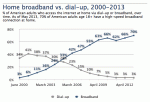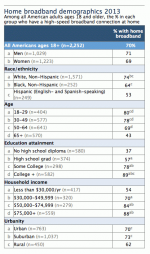
As Facebook teams up with other tech titans to put more effort into ubiquitous internet access worldwide, Pew Research is today is releasing the results of a survey that shows how one of the more advanced countries in the world, the U.S., is still not quite there in leading by example: 20% of U.S. adults are still without broadband or smartphones for internet access. And 3% of people in the country still using dial-up connections.
The think tank’s most recent survey notes that today 70% of adults in the country reported having broadband access at home as of May 2013, with the proportions of connected individuals increasing in wealthier households, by age and other factors like race.
Interestingly, Pew doesn’t seem to put this down to a digital divide but to consumer prefernce: “We’ve consistently found that age, education, and household income are among the strongest factors associated with home broadband adoption,” writes Kathryn Zickuhr, research associate for the Pew Research Center’s Internet Project and lead author of the report. “Many dial-up users cite cost and access as the main reasons they don’t have broadband, but for adults who don’t use the internet at all, a lack of interest is often the main issue.”
It’s not clear from Pew’s numbers how many of that 30% without broadband may opt to use the internet at work instead: a lack of interest for paying at home could be because they can use it at work already. But, what Pew has found is that there is some evidence of mobile substitution: with some 56% of U.S. adults now owning smartphones, 10% of respondents noted that they use these instead of broadband+computers.
That’s a far lower proportion than you see in some emerging countries, but is a sign that even in developed markets, as mobile networks get faster and less expensive, and phones get better, we may see more of this to come. (As a point of comparison, in Africa, the pace of mobile adoption has outstripped how quickly fixed line networks have been built out for over a decade now; in regions like this, mobile broadband will be the default for a critical mass of consumers.)
Lee Rainie, the director of Pews Internet and American Life project, says this is the first time that Pew has measured broadband usage and how it relates to smartphone ownership and usage, so it’s difficult to make a historic comparison. Pew notes, though, that the 70% figure is not because of access issues: some 98% of the population lives in internet broadband coverage areas, according to the Census Bureau’s July 2011 Current Population Survey.


